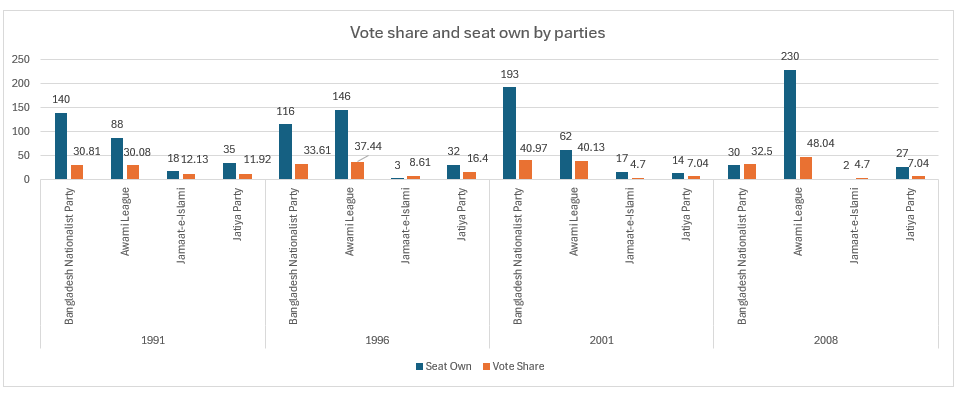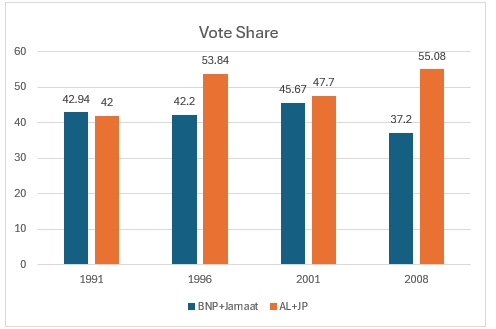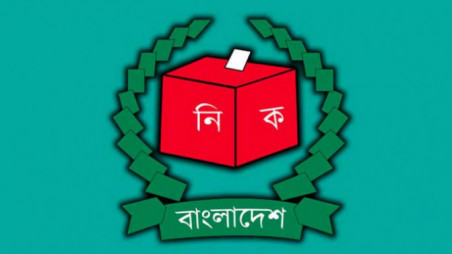By Kamal Sikder
Since the new interim government took office, various political parties, including Jamaat-e-Islami and numerous intellectuals, have voiced support for transitioning from Bangladesh’s current first-past-the-post (FPTP) electoral system to a proportional representation (PR) system. They argue this change would allow democracy to thrive. Jamaat Ameer Dr. Shafiqur, in defence of his party’s ten-point reform proposal, argued that in the FPTP system, the candidate with the highest votes wins the election. Still, often, this could represent only about 30% of the total vote count. Consequently, the majority who did not vote for this candidate ended up unrepresented. Dr. Shafiqur emphasised that many smaller parties, which often have capable leaders, are not elected to parliament under FPTP. However, when the total votes are tallied, it may show that a smaller party has gained 1%, 2%, 3%, or even 5% of votes nationwide, a statistic that goes unrecognised in seat allocation, which he claims is unjust. Additionally, under the current system, those with wealth secure nominations from major parties regardless of competence, turning parliament into what he describes as a “show of stooges.” By contrast, Dr. Shafiqur argues, a PR system would ensure that capable individuals could be elected to parliament as votes are cast in favour of a party, not merely individual candidates.
FPTP: A Legacy of the British System
Currently, 73 countries around the world utilize some form of proportional representation. The first-past-the-post voting system, however, is in use in fewer than 50 countries, mostly Commonwealth nations, meaning that Britain and its former colonies primarily use this system, with the exception of the Republic of Ireland. Notably, within the UK, Northern Ireland and Scotland employ a PR system in their local devolved parliamentary elections.
In recent years, some have called for the adoption of a PR system in Britain itself, though no national consensus has been achieved. As a compromise, Britain introduced a “second choice” option in local and national elections. This helps minimise FPTP’s drawbacks by allowing voters to rank a second choice, which can sometimes enable a candidate who did not have the majority in the first-choice count to win based on accumulated preferences. Under this system, candidates must secure over 50% of combined first- and second-choice votes.
PR System: What It Is and How It Works
In a proportional representation (PR) system, parties receive seats in parliament that correlate directly with the percentage of votes they win. This is in stark contrast to FPTP, where only the candidate with the most votes in each constituency wins, often leading to a mismatch between the percentage of votes a party receives and the seats it holds in parliament. In Bangladesh’s political landscape, where alliances shift frequently, adopting a proportional system could significantly alter election outcomes.
Proponents argue that the PR system brings many benefits. Primarily, it allows for fairer representation, as even smaller parties stand a better chance of securing seats in parliament. The PR system reduces the dominance of a two-party system, which is a common issue under FPTP. Currently, the United States and Britain, two prominent examples of FPTP-based democracies, have increasingly polarized, bipartisan political landscapes where smaller parties are struggling to survive. Bangladesh shows signs of moving in a similar direction. Looking at the past four elections, starting from the first free and fair election in 1991 to the most recent one held in 2008, it becomes evident that Bangladesh, too, is evolving towards a bipartisan system. Below is a summary table illustrating this trend:
| Year | Party | Vote Share |
|---|---|---|
| 1991 | Bangladesh Nationalist Party | 30.81% |
| Awami League | 30.08% | |
| Jamaat-e-Islami | 12.13% | |
| Jatiya Party | 11.92% | |
| 1996 | Bangladesh Nationalist Party | 33.61% |
| Awami League | 37.44% | |
| Jamaat-e-Islami | 8.61% | |
| Jatiya Party | 16.4% | |
| 2001 | Bangladesh Nationalist Party | 40.97% |
| Awami League | 40.13% | |
| Jamaat-e-Islami | 4.7% | |
| Jatiya Party | 7.04% | |
| 2008 | Bangladesh Nationalist Party | 32.5% |
| Awami League | 48.04% | |
| Jamaat-e-Islami | 4.7% | |
| Jatiya Party | 7.04% |

The table above illustrates that Bangladesh is moving toward a bipartisan system. Although the vote share of parties like Jamaat-e-Islami and Jatiya Party declined over time, under a PR system, these parties would likely secure more parliamentary seats than they would under the FPTP system. Additionally, PR would encourage coalition-building among parties to form governments, as it becomes challenging to achieve a majority with just 40% of the vote. It is worth noting that the vote share from the 2008 election is often excluded from discussions, as it is widely believed that this election was influenced by foreign powers, particularly India and the USA.
PR and Public Opinion
The PR system best mirrors public opinion as it aligns more closely with the country’s popular vote distribution. Moreover, PR ensures that no votes are wasted, a factor that often encourages voters to support smaller parties without fear that doing so will inadvertently lead to the victory of a less-preferred party. In past Bangladeshi elections, undecided voters and potential supporters of smaller parties have frequently shifted their choices at the last minute to avoid outcomes that do not align with their broader political identity.
Critiques of the PR System
The PR system is not without its disadvantages. Critics argue that it can, in the long run, reduce voter motivation, as voters may lose interest when direct competition diminishes. In a PR system, people vote for a party without certainty about their specific representative, and this disconnect can lead to frustration if the person elected is unfamiliar to them. This issue could be addressed by ensuring that MPs no longer have authority over local development matters—a significant role MPs currently play in Bangladesh under the FPTP system, giving them substantial influence over local affairs. In many cases, local administration becomes a tool for MPs or their affiliated parties. Some have suggested that Bangladesh’s election reform committee should recommend that MPs have no role in constituency development work, leaving this responsibility solely with the administration.
Moreover, PR can disproportionately empower smaller parties during coalition negotiations, allowing them to push agendas that may lack popular support. PR also enables parties with extreme ideologies to gain parliamentary representation. Recent trends in European politics demonstrate how far-right parties have gained traction and representation due to PR. The FPTP system, by contrast, limits such parties’ influence. For example, in the UK’s recent parliamentary election, the Reform Party, with a 14% vote share, won only five seats, while the Liberal Democrats, with 12%, secured 77 seats. PR would have allowed the Reform Party 94 seats, even though its support is concentrated in specific areas rather than nationwide, illustrating how PR might misrepresent regional support levels.
Political instability is another common issue in countries that use PR. Some European countries have experienced long delays in forming governments due to coalition negotiation deadlocks. While European countries generally have politically mature, educated populations who manage these challenges peacefully, a similar situation in Bangladesh could lead to military intervention, as the democratic process is not yet fully stable and public political literacy remains low.
Should Bangladesh Adopt Proportional Representation?
The PR system’s advantages are numerous, particularly in terms of fair representation and coalition encouragement. However, for a developing democracy like Bangladesh, it may not be the most suitable choice. The democratic process and public awareness in Bangladesh are still developing, and PR could destabilize governance, unintentionally empowering certain political coalitions and reinforcing existing divisions.
The issue of PR adoption surfaced amid recent political changes in Bangladesh. On August 5, 2024, a people’s uprising ousted Sheikh Hasina’s Awami League from power. Following this upheaval, most political parties except the Bangladesh Nationalist Party (BNP) advocated for PR as the future electoral model, acknowledging its theoretical benefits. However, PR could potentially restore representation for Awami League, a party whose voter base has historically remained around 30–40%, ensuring it a continued role in parliament. FPTP, on the other hand, might keep Awami League outside of the power structure for a longer period, reflecting its declining public support. Notably, it is challenging to definitively claim that Awami League’s support has entirely disappeared.
Additionally, the Hindu minority in Bangladesh, which constitutes 7.1% of the population, has consistently supported the Awami League. Under PR, this bloc would likely guarantee a stable support base for the party, thus securing representation. Similarly, an alliance between Awami League and Jatiya Party would benefit from PR, ensuring that both parties receive seats proportionate to their votes rather than facing potential underrepresentation under FPTP. This dynamic could ensure a consistent 40–42% vote share for an Awami League–Jatiya Party coalition, which may allow them to dominate the political landscape.
Conversely, if BNP and Jamaat were to join forces under PR, they might achieve a larger seat count corresponding to their combined vote share, but it may still not be enough for a majority if the Awami League–Jatiya Party coalition maintains its strong base.
| Group/Year | 1991 | 1996 | 2001 | 2008 |
|---|---|---|---|---|
| BNP+Jamaat | 42.94% | 42.2% | 45.67% | 37.2% |
| AL+JP | 42% | 53.84% | 47.7% | 55.08% |
Combined Vote Share of BNP+Jamaat and AL+JP
The combined vote share of the Awami League and Jatiya Party has shown a steady increase over the years, while the combined share of BNP and Jamaat has fluctuated, peaking in 2001 but dropping by 2008. In 2001, the BNP-Jamaat alliance was able to win many seats despite a narrow vote-share difference with Awami League-Jatiya Party, highlighting the advantages of the FPTP system for alliances. The 2008 election marked a significant turning point, with the Awami League-Jatiya Party alliance achieving a substantial lead, possibly due to dissatisfaction with BNP’s governance and public alignment with Awami League’s platform.

Conclusion
It is uncertain how much public support the Awami League has retained in Bangladesh. Historically, Bangladeshi politics have been deeply polarised, with a limited number of swing voters. Small shifts among these voters can often determine election outcomes. Both BNP and Jamaat are seen as leaning right on the political spectrum, and several other political groups in Bangladesh share similar leanings, dividing the right-leaning vote. Meanwhile, Awami League, a left-leaning party, enjoys a relatively consolidated support base. This fragmentation on the right may allow the Awami League to regain power if it is allowed to participate in the political process.
Thus, while PR may not fundamentally alter Bangladesh’s political landscape, it could solidify and even worsen the current political divisions. A transition to PR may not yield the desired outcomes and could be potentially detrimental to Bangladesh.










